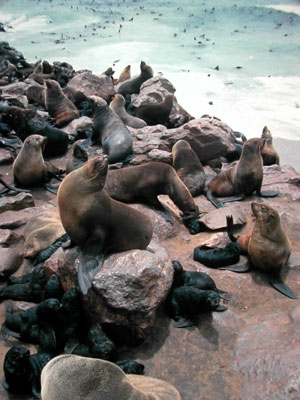|
| 질의: african lion | 결과: 156번째/766 | |
Fur Seals (part of Family: Otariidae) - Wiki
| 제목: | Fur Seals (part of Family: Otariidae) - Wiki
| |

| 해상도: 300x400
파일크기: 38147 Bytes
등록시간: 2007:12:21 15:17:38
|
Fur seal
From Wikipedia, the free encyclopedia
Order: Carnivora
Suborder: Pinnipedia
Family: Otariidae
Genera: Callorhinus Arctocephalus
[Photo] Cape fur seal (Arctocephalus pusillus pusillus). Picture taken at Cape Cross, Namibia, Dec. 2003. Date 20031222. Author: bries. | Permission is granted to copy, distribute and/or modify this document under the terms of the GNU Free Documentation License, Version 1.2 or any later version published by the Free Software Foundation; with no Invariant Sections, no Front-Cover Texts, and no Back-Cover Texts. A copy of the license is included in the section entitled "GNU Free Documentation License". |
Fur seals refers to nine species of pinnipeds in the eared seal (Otariidae) family which also includes the sea lions. A sole species in the Callorhinus genus (the northern fur seal) inhabits the North Pacific, while seven species in the Arctocephalus genus are found primarily in the Southern hemisphere. They are marked by their dense underfur in contrast to the coarse and sparse guard hairs of the sea lions.
Taxonomy
Until recently, fur seals were all grouped under a single subfamily called Arctocephalinae based on the most prominent common feature between all species, namely the coat of dense underfur intermixed with guard hairs. Recent genetic evidence, however, suggests that Callorhinus is more closely related to some sea lion species, and the fur seal/sealion subfamily distinction has been eliminated from most taxonomies. Nonetheless, all fur seals have certain features in common: the fur, generally smaller sizes, farther and longer foraging trips, smaller and more abundant prey items, great sexual dimorphism and a history of commercial exploitation. For these reasons, the distinction remains useful.
Physical appearance
Fur seals share with other otariids the ability to turn their rear limbs forward and move on all fours. Fur seals are generally smaller than sea lions - at under 1 m, the Galapagos fur seal is the smallest of all pinnipeds. However, their flippers tend to be proportionately longer, their pelage tends to be darker and the vibrissae more prominent. Males are often more than five times heavier than the females, making them among the most sexually dimorphic of all mammal groups.
Behavior and ecology
Fur seals gather in large herds once a year to breed on beaches or rocky outcrops. While the northern fur seal males will aggressively defend their harems. After giving birth, females go on extended foraging trips, sometimes up to a week, returning to the rookery to feed their pups until they are weaned. Fur seals are carnivorous, feeding on fish, squid and krill. They are preyed upon by sharks, killer whales, and occasionally larger sea lions.
Exploitation
Many fur seal species were heavily exploited by commercial sealers, especially during the 19th century when their fur was highly valued. Many populations, notably the Guadalupe fur seal, northern fur seal and Cape fur seal, suffered dramatic declines and are still recovering. Currently, most species are protected and hunting is mostly limited to subsistence harvest. Globally, most populations can be considered healthy, mostly due to the fact that they often prefer remote habitats that are relatively inaccessible to humans. Nonetheless, environmental degradation, competition with fisheries and climate change potentially pose threats to some populations.
Species
Family Otariidae
Genus Arctocephalus
Antarctic Fur Seal, Arctocephalus gazella
Guadalupe Fur Seal, Arctocephalus townsendi
Juan Fernandez Fur Seal, Arctocephalus philippii
Galapagos Fur Seal, Arctocephalus galapagoensis
Cape Fur Seal, Arctocephalus pusillus
- South African Fur Seal, Arctocephalus pusillus pusillus
- Australian Fur Seal, Arctocephalus pusillus doriferus
New Zealand Fur Seal or Southern Fur Seal, Arctocephalus forsteri
Subantarctic Fur Seal, Arctocephalus tropicalis
South American Fur Seal, Arctocephalus australis
Genus Callorhinus
Northern Fur Seal, Callorhinus ursinus
http://en.wikipedia.org/wiki/Fur_seal
| The text in this page is based on the copyrighted Wikipedia article shown in above URL. It is used under the GNU Free Documentation License. You may redistribute it, verbatim or modified, providing that you comply with the terms of the GFDL. |
|
댓글 |
|---|
| | 손님 |
|
Fur Seals
They are mammals.
They have a thick coat of very fine hair, long whiskers and tiny ears.
They spend most of their time out in the ocean.
They are excellent swimmers and love to play together.
They have excellent eyesight and hearing.
What do they eat? Fish, lobster and octopus!
They can hold their breath underwater for up to an hour but they have to come up to the surface to breathe.
They drown if they get caught in underwater fishing nets.
In spring and summer they come onto rocky bits of coastline to mate and have their babies. They come to the same place each year. These places are called rookeries.
Males are called bulls. They are much bigger than the females. Males fight for the right to mate with some of the females.
Females are called cows.
Babies are called pups.
- Cows give birth to 1 pup a year.
- Fur seal pups drink milk from their mother's nipples.
- Mothers recognise their pup by its smell and its special call.
- When the pups are about 8 months they go to sea to learn how to find their own food.
Fur seals could live to be 20 years old. |
^o^
동물그림창고 똑똑전화 누리집
^o^
|
|
|